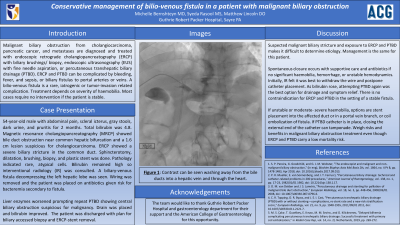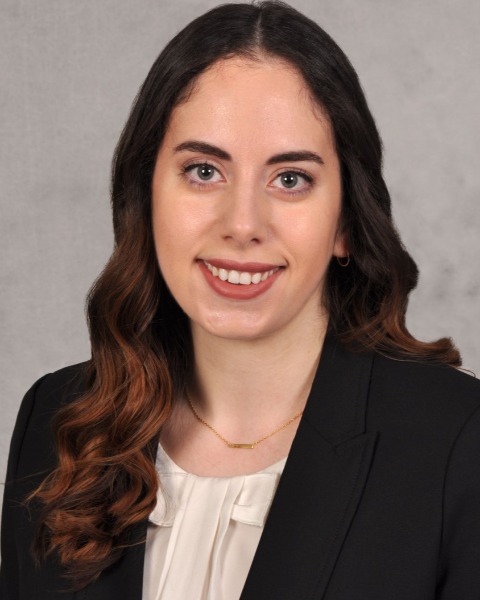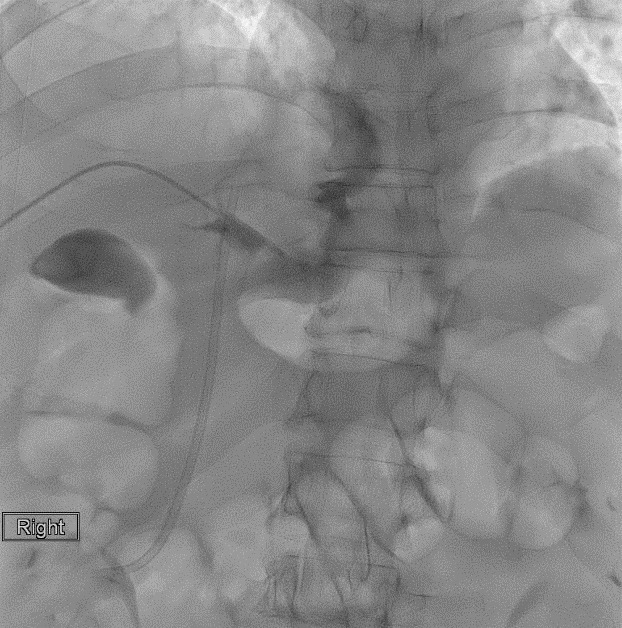Tuesday Poster Session
Category: Biliary/Pancreas
P2977 - Conservative Management of Bilio-Venous Fistula in a Patient With Malignant Biliary Obstruction
Tuesday, October 24, 2023
10:30 AM - 4:00 PM PT
Location: Exhibit Hall

Has Audio

Michelle Bernshteyn, MD
Guthrie Robert Packer Hospital
Sayre, PA
Presenting Author(s)
Michelle Bernshteyn, MD, Syeda Rasool, BS, MS, Matthew Lincoln, DO
Guthrie Robert Packer Hospital, Sayre, PA
Introduction: Malignant biliary obstruction from cholangiocarcinoma, pancreatic cancer, and metastases are diagnosed and treated with endoscopic retrograde cholangiopancreatography (ERCP) with biliary brushings/ biopsy, endoscopic ultrasonography (EUS) with fine needle aspiration, or percutaneous transhepatic biliary drainage (PTBD). ERCP and PTBD can be complicated by bleeding, fever, and sepsis, or biliary fistulas to portal arteries or veins. A bilio-venous fistula is a rare, iatrogenic or tumor-invasion related complication. Treatment depends on severity of haemobilia. Most cases require no intervention if the patient is stable.
Case Description/Methods: 54-year-old male with abdominal pain, scleral icterus, gray stools, dark urine, and pruritis for 2 months. Total bilirubin was 4.8. Magnetic resonance cholangiopancreatography (MRCP) showed bile duct obstruction near common hepatic bifurcation and a 1.6 cm lesion suspicious for cholangiocarcinoma. ERCP showed a severe biliary stricture in the common duct. Sphincterotomy, dilatation, brushing, biopsy, and plastic stent was done. Pathology indicated rare, atypical cells. Bilirubin remained high so interventional radiology (IR) was consulted. A biliary-venous fistula decompressing the left hepatic lobe was seen. Wiring was removed and the patient was placed on antibiotics given risk for bacteremia secondary to fistula.
Liver enzymes worsened prompting repeat PTBD showing central biliary obstruction suspicious for malignancy. Drain was placed and bilirubin improved. The patient was discharged with plan for biliary accessed biopsy and ERCP-stent removal.
Discussion: Suspected malignant biliary stricture and exposure to ERCP and PTBD makes it difficult to determine etiology. Management is the same for this patient.
Spontaneous closure occurs with supportive care and antibiotics if no significant haemobilia, hemorrhage, or unstable hemodynamics. Initially, IR felt it was best to withdraw the wire and postpone catheter placement. As bilirubin rose, attempting PTBD again was the best option for drainage and symptom relief. There is no contraindication for ERCP and PTBD in the setting of a stable fistula.
If unstable or moderate- severe haemobilia, options are stent placement into the affected duct or in a portal vein branch, or coil embolization of fistula. If PTBD catheter is in place, closing the external end of the catheter can tamponade. Weigh risks and benefits in malignant biliary obstruction treatment even though ERCP and PTBD carry a low mortality risk.

Disclosures:
Michelle Bernshteyn, MD, Syeda Rasool, BS, MS, Matthew Lincoln, DO. P2977 - Conservative Management of Bilio-Venous Fistula in a Patient With Malignant Biliary Obstruction, ACG 2023 Annual Scientific Meeting Abstracts. Vancouver, BC, Canada: American College of Gastroenterology.
Guthrie Robert Packer Hospital, Sayre, PA
Introduction: Malignant biliary obstruction from cholangiocarcinoma, pancreatic cancer, and metastases are diagnosed and treated with endoscopic retrograde cholangiopancreatography (ERCP) with biliary brushings/ biopsy, endoscopic ultrasonography (EUS) with fine needle aspiration, or percutaneous transhepatic biliary drainage (PTBD). ERCP and PTBD can be complicated by bleeding, fever, and sepsis, or biliary fistulas to portal arteries or veins. A bilio-venous fistula is a rare, iatrogenic or tumor-invasion related complication. Treatment depends on severity of haemobilia. Most cases require no intervention if the patient is stable.
Case Description/Methods: 54-year-old male with abdominal pain, scleral icterus, gray stools, dark urine, and pruritis for 2 months. Total bilirubin was 4.8. Magnetic resonance cholangiopancreatography (MRCP) showed bile duct obstruction near common hepatic bifurcation and a 1.6 cm lesion suspicious for cholangiocarcinoma. ERCP showed a severe biliary stricture in the common duct. Sphincterotomy, dilatation, brushing, biopsy, and plastic stent was done. Pathology indicated rare, atypical cells. Bilirubin remained high so interventional radiology (IR) was consulted. A biliary-venous fistula decompressing the left hepatic lobe was seen. Wiring was removed and the patient was placed on antibiotics given risk for bacteremia secondary to fistula.
Liver enzymes worsened prompting repeat PTBD showing central biliary obstruction suspicious for malignancy. Drain was placed and bilirubin improved. The patient was discharged with plan for biliary accessed biopsy and ERCP-stent removal.
Discussion: Suspected malignant biliary stricture and exposure to ERCP and PTBD makes it difficult to determine etiology. Management is the same for this patient.
Spontaneous closure occurs with supportive care and antibiotics if no significant haemobilia, hemorrhage, or unstable hemodynamics. Initially, IR felt it was best to withdraw the wire and postpone catheter placement. As bilirubin rose, attempting PTBD again was the best option for drainage and symptom relief. There is no contraindication for ERCP and PTBD in the setting of a stable fistula.
If unstable or moderate- severe haemobilia, options are stent placement into the affected duct or in a portal vein branch, or coil embolization of fistula. If PTBD catheter is in place, closing the external end of the catheter can tamponade. Weigh risks and benefits in malignant biliary obstruction treatment even though ERCP and PTBD carry a low mortality risk.

Figure: Contrast can be seen washing away from the bile ducts into a hepatic vein and through the heart.
Disclosures:
Michelle Bernshteyn indicated no relevant financial relationships.
Syeda Rasool indicated no relevant financial relationships.
Matthew Lincoln indicated no relevant financial relationships.
Michelle Bernshteyn, MD, Syeda Rasool, BS, MS, Matthew Lincoln, DO. P2977 - Conservative Management of Bilio-Venous Fistula in a Patient With Malignant Biliary Obstruction, ACG 2023 Annual Scientific Meeting Abstracts. Vancouver, BC, Canada: American College of Gastroenterology.
